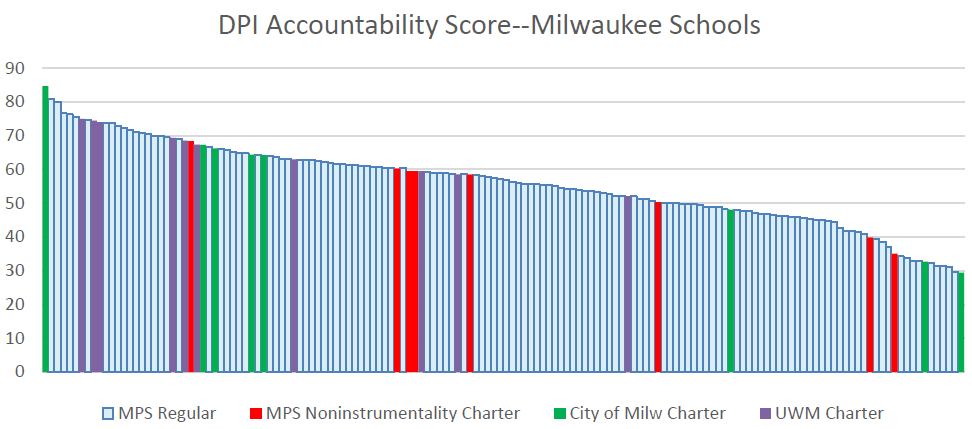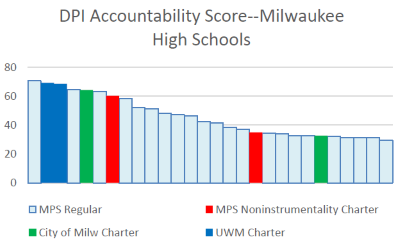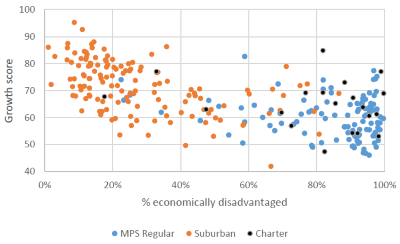How Good Are Charter Schools?
The data is very encouraging, so why are liberals so opposed?
Recently the Milwaukee Teachers’ Education Association has made a major push against charter schools, often arguing they are ineffective educationally. So I decided to take a look at their performance.
Charter schools are independent public schools. Generally they have their own board of directors that contracts with an authorizing entity. In Milwaukee, UW-Milwaukee, the Milwaukee Common Council, and the Milwaukee School Board can authorize charters. (MATC can also authorize charters but has not done so.) The contracts with the authorizers usually emphasize the results the school is expected to obtain. Authorizers do not generally involve themselves in day-to-day school operations.
As public schools, charters also have to meet certain requirements. They cannot select their students. If there are more applicants than spaces the school is expected to hold a lottery. The charter schools cannot be religious. Within these requirements and the terms of their contract, the schools are free to make their own decisions. (Full disclosure: I am on the board of a charter school.)
Recently the Wisconsin Department of Public Instruction (DPI) has started issuing “school report cards” on every Wisconsin public school including charter schools. Schools accepting vouchers are not included, which I think is unfortunate since parents considering those schools deserve good information. Competitive markets can only operate effectively if there is good information. In this regards, Governor Scott Walker’s proposal to allow schools to use tests of their choosing would represent a step in the wrong direction, making comparisons more difficult.
The DPI attempts to sum up the information on public schools with an Overall Accountability Score which determine whether or not a school meets expectations. The chart below shows the accountability scores for Milwaukee public schools, ranked from highest to lowest.
The biggest group of schools (light blue color) includes two groups of MPS schools: regular MPS schools and so-called “instrumentality charters.” The latter are schools that use regular MPS staff but supposedly are given more autonomy. However, so far as I know, none have their own board and in the case of layoffs, staff in other schools may have the right to bump teachers with less seniority in the charter school. Although some—particularly small teacher-led schools—have a charter-like feel, many differ little from regular MPS schools, for instance using the MPS standard curriculum.
The red color indicate MPS “noninstrumentality” charters. Unlike instrumentality charters, these are schools that have their own boards and hire their own staff, and thus may be quite different than traditional MPS schools. The final two groups are charters authorized by the Milwaukee Common Council (shown in green) and UWM (dark blue).
Looking at the Overall Accountability Scores, you can see charter schools fall all along the spectrum, but are clustered more heavily at the higher end of accountability scores. Their average score is somewhat higher than that for MPS schools and the difference is significant with 90 percent confidence. Among the authorizers, UWM’s average is highest, reflecting the lack of schools at the lower end, although the highest-scoring school in Milwaukee is chartered by the Common Council.
One of the measures included in the DPI report card is the “growth score.” This is calculated by comparing the math and reading scores of individual students with their scores in previous years. Schools that don’t have before and after scores are not included. This results in the elimination of new schools and high schools, where the testing only takes place in 10th grade.
The chart below shows the results for public schools in Milwaukee where growth scores can be calculated.
Again, charter schools fall throughout the range, but are clustered at the upper end, meaning the growth for students is greater. The difference is statistically significant at the 99 percent level. Charters authorized by the City of Milwaukee have the highest average, perhaps reflecting the emphasis placed on student academic growth by the city’s consultants, but the highest score was obtained by a school chartered by MPS.
The next chart shows the DPI Accountability scores for high schools (as mentioned, no growth scores are available). The MPS high schools at the top of the scale have admissions requirements (full disclosure: as a member of the school board I authored the resolution to allow admissions standards). Again, charter schools cluster near the top. The average difference is statistically significant, but only at the 90 percent level.
The first message from this data is that charter schools more than hold their own when compared to more traditional Milwaukee public schools, but there is enormous variation among the charter schools.
The second message is that for parents searching for the right school for their child the question of its governance (charter vs. MPS, etc.) should be near the bottom of their considerations. The DPI information is helpful, but doesn’t by itself tell which school is best for a particular child. (It always helps to visit the school.)
It should be noted that neither the Overall Accountability Score nor the Growth Score is a true value-added measure, that attempts to separate the effect of school instruction from the many other factors that influence a child’s academic performance. Of the two, the Growth Score probably comes closer, but is still affected by the population of students the school receives.
At this point it is probably wise to bring up one of the standard cautions of statistics: that correlation does not prove causation. The better performance of charter schools as a whole could reflect any one of many factors, including the benefits of independence, the higher commitment of families choosing them to education, or a greater willingness of charter authorizers to pull the plug on weak schools.
So far, this discussion has been limited to schools within the city of Milwaukee. The chart to the right includes suburban schools in the Milwaukee metropolitan area. The horizontal axis plots the percentage of students in the school who are considered economically disadvantaged. The vertical axis plot the school’s growth score.
As you can see, the surburban schools (in orange) cluster toward the left because they tend to have a small percentage of low-income students while city schools (in blue) cluster toward the right, with high percentages of low-income students. This huge difference is consistent with studies that find the Milwaukee metropolitan area heavily segregated. And you can see on average, lower-income students perform more poorly. The very large scatter, however, indicates that different schools can differ substantially in their success with apparently similar student populations.
One notable pattern is the apparent downward slope on the left side of the graph, for the orange schools. This suggests that learning in suburban schools drops with even small increments of students who are economically disadvantaged. But the wide scatter suggests that some schools are able to cope better than others.
The most persistent critic of charter schools has been the Milwaukee Teachers’ Education Association or MTEA. It, of course, has an obvious economic interest in supporting only MPS schools which are staffed by union members. Somewhat surprisingly, the MTEA has never been a strong supporter or enabler of instrumentality charter schools, which employ MTEA members, perhaps reflecting union preference for rule-based regimes.
In its opposition to charters the MTEA has often been backed by a variety of left-leaning organizations. The most recent incarnation goes under the name of Schools and Communities United (S&CS), which follows the lead of the MTEA when it comes to charter schools.
Other charter opponents are harder to figure. Considering the average enrollment in Milwaukee charter schools is 90 percent black or Hispanic, one might expect that organizations like the NAACP or Voces de la Frontera would embrace charters as giving more options to people they serve. Similarly one might expect that MICAH — the Milwaukee Inner-city Congregations Allied for Hope — would support giving residents of the inner city greater educational opportunities.
In understanding the motivation of the groups opposing charters, it may be helpful to consider those at the opposite end of the ideological spectrum. On the right a large number of people take Ronald Reagan’s famous assertion that “government is not the solution to our problem; government is the problem” as their polestar. In their view, new government programs are always bad, privatization is always good. For someone with such a binary viewpoint, Barack Obama looks like a socialist.
The groups opposing charter schools, it appears, have adopted the Tea Party’s binary world viewpoint but reversed the values. For them, privatization is bad and government good. Thus the effectiveness of a charter school is a moot issue, in this view.
Last spring the MPS administration proposed that some of its lowest-performing schools be converted to charter schools. Under pressure from the MTEA, this initiative was rejected. Instead the schools are to be replaced by something called “community schools.” It is unclear what these would be. So far, nothing has been put forth.
A hint of what is meant by a community school is contained within a publication put out by Schools and Communities United, called Fulfill the Promise. It includes a profile of an MPS school, described as “a model of civic engagement.” Perhaps but this school is struggling academically: its MPS report card describes it as “fails to meet expectations,” the lowest category, and its rating for student growth is well under the state average. The article gives no hint of these problems.
If this school had been a charter school rather than part of MPS, it’s likely the tone would have been lacerating, demanding that its charter be withdrawn. A taste of how this group treats struggling charter school can be gained from this article in the Shepherd Express.
In the long run, the strategy adopted by the anti-charter groups is likely to be counter-productive to their cause. By concentrating all their energies on fighting charter schools, rather than helping MPS improve to better compete against charter schools, they reinforce the impression in Madison that MPS is unable to reform itself without outside intervention. They may ultimately lend support to legislators proposing to create a recovery district to take over the lowest-performing MPS schools.

























Good article. I have no problem with charter schools. I think people get confused thinking that they can be religious. That’s a different argument!
Agreed. Good piece. I’ll admit to conflating “charter” and “voucher” schools. Is there a teacher accreditation requirement for charter schools?
I think it is easier if we all said public charter schools vs private voucher schools. My son went to private voucher school – Tamarak and it was a nightmare. His kindergarden teacher barely had a degree. Some claimed she did others said she never finished paying for her classes and still owed UWM money. Either way it was in computer science. She told me my son was developmentally disabled and would never read and write. She said he had eye tracking issues and would never learn to add or do math. We took him to eye doctors – he did great on eye tests. We took him to the pediatrician. She said they were crazy. He met all developmental milestones. The other teachers at Tamarak – one a massage therapist kindergarden teacher, and the administrator all agreed, our son was the problem. Our son grew more and more depressed and sad. It took weeks to for Tamarak – this private voucher school to even call us back and acted like children themselves were so unprofessional and shaming we felt like abused spouses. We left.
Joyously we found a great school at Woodlands – a public charter school. There our son learned to read, write, do math and within 18 months not only caught up with the un-credentialed teachers at Tamarak were unable to do but he has even surpassed his reading level and loves math. Voucher schools are garbage.
I taught at a charter high school from 2004-2006. It was located inside of North Division (at that time there were a bunch of small schools in there). At that time to teach you only needed a bachelor’s degree, which was a serious problem. Staff turnover was insanely high and there were many unqualified teachers. The school was a total mess, but that’s another story, and apparently most charters in Milwaukee are pretty good.
I think the plan to allow people with job experience but no formal teacher training to teach is a terrible one. I had formal teacher training and I was still totally unprepared for the reality of teaching in Milwaukee. Most people will be in way over their head if they transition from the business world to teaching.
The chart that includes suburban schools is interesting. My general impression is that once schools have 40% or more of their student population in the economically disadvantaged category, there is no difference in performance between MPS and suburban schools. I suspect that the chart is still misleading in that there are vast differences in levels of economic disadvantage. I suspect there is greater number of students in MPS who are in the severely economically disadvantaged category, not to mention higher numbers of students with disabilities and who are English language learners in addition to being economically disadvantaged. MPS performance could actually be much better than suburban schools with this properly factored in.
I have a 7th grader in MPS and a 1st grader at a public charter (Woodlands East). We’ve been happy with both schools, the major difference (beyond pedagogy) being the parent involvement at the charter school is much higher. All of the scary stories we’ve heard about charter schools have turned out to be false and we’re grateful these options exist. I think many people do confuse charter/voucher/choice because they have a similar conceptual base. But throwing out public charter schools because of idealogy is as ignorant as calling MPS teachers “thugs.”
Dave,
Here is the applicable part of Wisconsin law:
(d) The chartering or contracting entity under par. (b) shall do all of the following:
1. Ensure that all instructional staff of charter schools under this subsection hold a license or permit to teach issued by the department.
Can you simplify that, Bruce? License or permit issued by authorizing authority? How does that compare to “normal” public school teachers?
The sub-head to this story asks, “Why are liberals so opposed?” Two possible answers: One, many people (perhaps not only “liberals,” whoever they are,) don’t know the difference between voucher and charter schools, and they fear (not unreasonably) that voucher money pulled out of public education to fund private education risks leaving the public-school enterprise weakened. A related, second reason: even though charters are public, the more facilities and programs vying for scarce resources, the fewer resources remaining for those students in non-charter, public programs. The philosophy behind charter schools was in part to enable innovation within public education so that a district as a whole could learn from the experiences and results of the charter(s.) It would be interesting to know to what extent Milwaukee’s charter experience has made that possible.
Giving parents a choice of where to send their child is the wrong focus. Two prevailing issues are: 1) the question and ensuing action should be: How can we develop the finest educational outcomes in the USA for Wisconsin students and 2) by focusing on student learning outcomes society benefits, which translates into lower crime rates, lower incarceration rates [$30K-$90K per year per person to sustain incarceration], greater sense of contribution to society by its members and a future for our youth!
The data is very encouraging, so why are liberals so opposed?
I would contend only teacher unions and their sympathizers are opposed. Money and power are at risk. Not surprising.
The article asks “why are liberals so opposed?”… I’m not sure that you’ve shown that “liberals” are opposed to Charter schools. Some groups that ally themselves with liberals are; do you have any polling data that explicitely differentiates between choice & voucher schools while showing that “liberals” are opposed?
I expect crickets.
Yes money and power are at risk.
The power is the power of democracy. Can a system of elected representatives have a substantive discussion of pedagogy and factor in social-economic issues? Mr Thompson has been an elected member of school board and his bias may be peaking out from behind his statistical cloak.
The issue of money: The division of resources created by private charters and vouchers may well be detrimental to apply maximum force to counter the intellectual damage done to youth by poverty and discrimination.
I have no problems with charters as long as charters are done within the local democratically controlled MPS budget and we use social scientific analysis to determine what pedagogies work best. I do not believe unions are inherently destructive to good public education, nor do I believe that experimentation cannot be done with the framework of a public school system.
Having charter schools authorized by entities other than Milwaukee Public Schools and its elected board has the potential to complicate the gathering and analysis of data to evaluate performance. It also may hamper the dissemination of innovations gained by experimentation. How well are UWM and the City of Milwaukee collaborating with MPS on the effectiveness, (or lack of), in the charter schools they authorized. If we are to improve our public school system, then dollars should remain there as well as the oversight.
Generally speaking, whatever type of school it is, it’s only as good as its teachers. The plan to ease teacher qualifications and allow people with so-called real world experience to teach without proper training and credentials is a bad one. I don’t care how successful you were in the private sector. Teaching is not like business. Most people will be totally unprepared for the reality of teaching and eaten alive without adequate preparation.
…guess I answered my own question (#8).
“Pursuant to Wis. Stat. 118.19, “any person seeking to teach in a public school, including a charter school, or in a school or institution operated by a county or the state shall first procure a license or permit” from the Wisconsin Department of Public Instruction.
General requirements for educator licensing in Wisconsin (unless otherwise specified under each license type):
A minimum of bachelor’s degree.
Completion of an approved educator preparation program, including meeting all applicable Wisconsin statutory requirements and testing requirements.
Satisfactory background checks result.”
http://tepdl.dpi.wi.gov/licensing/educator-licensing
There is nothing wrong with Charter schools, but you can not compare them to public schools because they aren’t playing by the same rules. Public schools have to accept every student, Charter schools can keep out the students that would hurt the education experience of everyone else in the classroom. So when you look at data it looks like Charter schools do better because they get to pick their students, where as the public school gets whatever else is left out there.
If what Walter (17) says is true…and my readings suggest it is, that is a huge difference. Now it’s apples and oranges…visit a class with one or two “needs” students in a public school and watch the resources needed for them alone.
So if we are to take tax payer dollars and reallocate to Charter/private/whatever schools, and you allow the above “unleveled” playing field to continue, you will eventually destroy the public schools, IMO.
Further, I get the need to try different options in Milwaukee. But Ozaukee County, where public schools receive an award every other week for academic excellence, why would any sane person wish to reallocate those tax payer dollars?
If someone wants to send their kids to a religious school, “God Bless” them….but not with tax payer dollars.